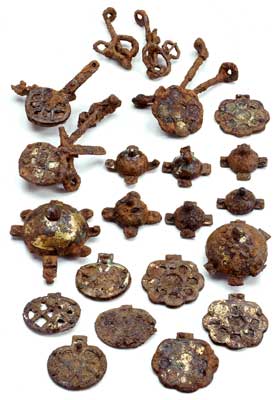Nakamura No. 1 Tomb: Rarely found nationwide, a tomb with an unopened horizontal stone chamber. From the conditions within, Kofun period views of life and death draw close.


Stone chamber
(plan), Nakamura No. 1 tomb
The chamber is
divided into a passageway, antechamber, and burial chamber. A
house-shaped sarcophagus with a side entrance was placed in the
burial chamber, a simple unlidded sarcophagus in the antechamber, and
the passageway sealed with numerous large round stones. Grave goods
were placed throughout the chamber, leaving no place for one to
stand.
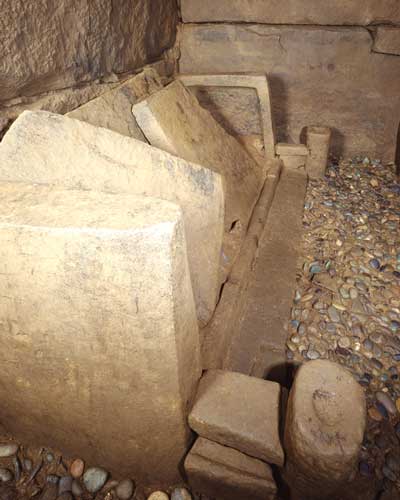
Composite
house-shaped sarcophagus with a side entrance, stone lanterns | |
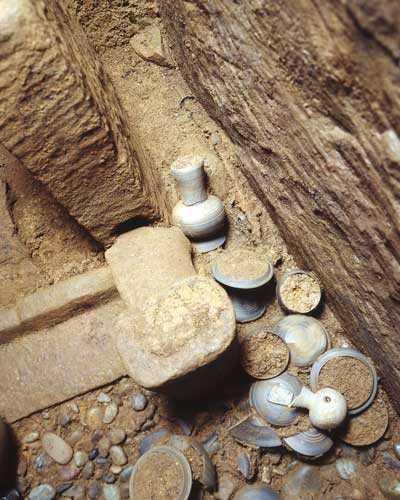
Grave goods in
situ |
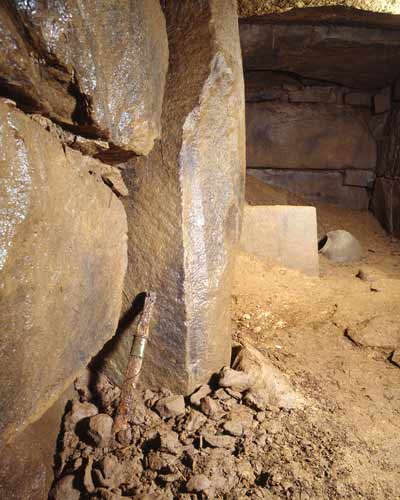
An ornamented
sword stood up in the antechamber (prior to excavation) |

Two cultural
spheres of the Izumo region
The eastern and
western spheres of Izumo as seen from the distribution of stone
chamber types.
Artifacts, Nakamura No. 1 Tomb

Ornamented swords
Late Kofun period,
end of sixth ∼ first half of seventh centuries.
Length: (item at top) 97 cm; (item at bottom) 86.2 cm.
Two of the 3 ornamented swords recovered from the stone chamber. They were found standing up in the antechamber and burial chamber. They are ceremonial swords, decorated with gold, silver, and copper.
The item at bottom is from the antechamber. The wood of the hilt decomposed as it was left standing, and silver wire that had been wrapped around it slid downward on the blade.
The item at top is from the burial chamber. As the reconstructed length would exceed 120 cm, it would be too long for a single person to draw from the scabbard. It was likely a ceremonial item.
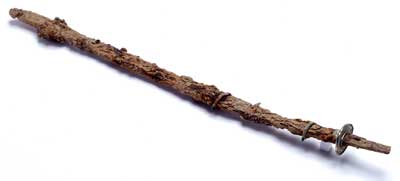
Ornamented sword |
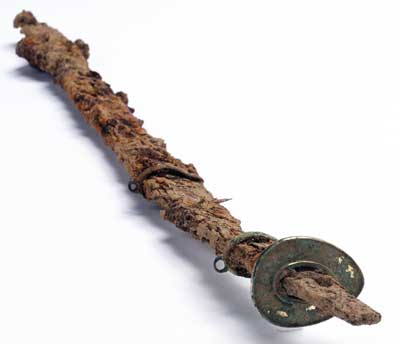
Ornamented sword, showing metal fittings for attaching a cord |
|
Recovered in a horizontal position, from the space in between the house-shaped coffin and back wall of the burial chamber. The glittering gilt bronze hand guard is well preserved. | |
Nakamura No. 1 Tomb, Izumo City, Shimane Prefecture
An unopened tomb, Nakamura No. 1
The Nakamura No. 1 tomb is a round mound approximately 30 m in diameter, built in the latter half of the Late Kofun period (end of the sixth to the first half of the seventh centuries). It is extremely rare as a tomb undisturbed by robbers prior to its discovery.
The entrance to the stone chamber is on the west side of the mound, facing the mountains.
The chamber is composite in structure, with an antechamber linked to the burial chamber, and is approximately 10 m in overall length and 2 m high, with a back wall composed of two enormous stones piled together, and large stones also used in the lateral walls above the base. The floor is paved with pebbles.
Along the north lateral wall of the burial chamber is a composite house-shaped sarcophagus with a side entrance, in front of which stood two stone lanterns which held votive flames. In the antechamber, along the northern wall was placed a simple unlidded sarcophagus (a bier enclosed by stone partitions).
The tomb was accidentally discovered during construction on 2 May 2002, and subsequently the minimal degree of excavation for the purpose of preservation has been conducted.
A tomb combining two different cultures of Izumo
Shimane prefecture divides into the three regions of Izumo in the east, Iwami to the west, and the remote island of Oki. Seen from the burial facilities of tombs, Izumo of the sixth century was divided into two spheres, an eastern one with sarcophagus-like stone chambers, and a western one where horizontal stone chambers were distributed, each thought to have its own set of powerful figures.
The Nakamura No. 1 tomb is in a corner of the western sphere of Izumo, but its stone chamber has characteristics of the west while the house-shaped sarcophagus has those of the east, revealing that its occupant was an important figure capable of dealing with influential groups of both eastern and western Izumo.
A sealed stone chamber
The approximately 6-m long passageway into the chamber was sealed with unworked stones the size of a person's head for nearly all of its length, and being thus completely buried, maintained a perfectly sealed condition for roughly 1,400 years. As a result, the tomb is extremely rare even on a nationwide scale, where the undisturbed condition of the chamber can be observed. A scene perhaps viewed only by the dead is visible at the Nakamura No. 1 tomb to people of the present day. It was learned that after the deceased was interred, the passageway was sealed, and rites conducted outside with large jars and an Izumo style pedestaled vase with miniatures attached to the shoulder.
Multifarious grave goods
Grave goods included 3 ornamented swords, 3 knives, approximately 100 iron projectile points (fragmented), 3 sets of equestrian gear, 3 bells, 2 glass beads, 1 gilt earring, 1 mirror decorated with papillae, and 60 pieces of Sue ware, together totaling more than 2,000 items.
Among these, two of the ornamented swords were recovered in the unusual position of having been stood leaning against the wall. The tomb is thought to have been constructed at the end of the sixth century, when the first burial was conducted, with a subsequent burial taking place in the seventh century.
In the western sphere of Izumo are the Imaichi Dainenji and Kami En'ya Tsukiyama tombs, both Historic Sites that are top class nationwide in terms of scale and grave goods. Based on its size, Nakamura No. 1 is thought to be of the next rank below these two. But its variety of grave goods is in no way inferior, and particularly from the perspective that it enables reconstruction of mortuary rites from 1,400 years ago, it can surely be called a precious tomb on a national scale. (Sakamoto Toyoharu)

